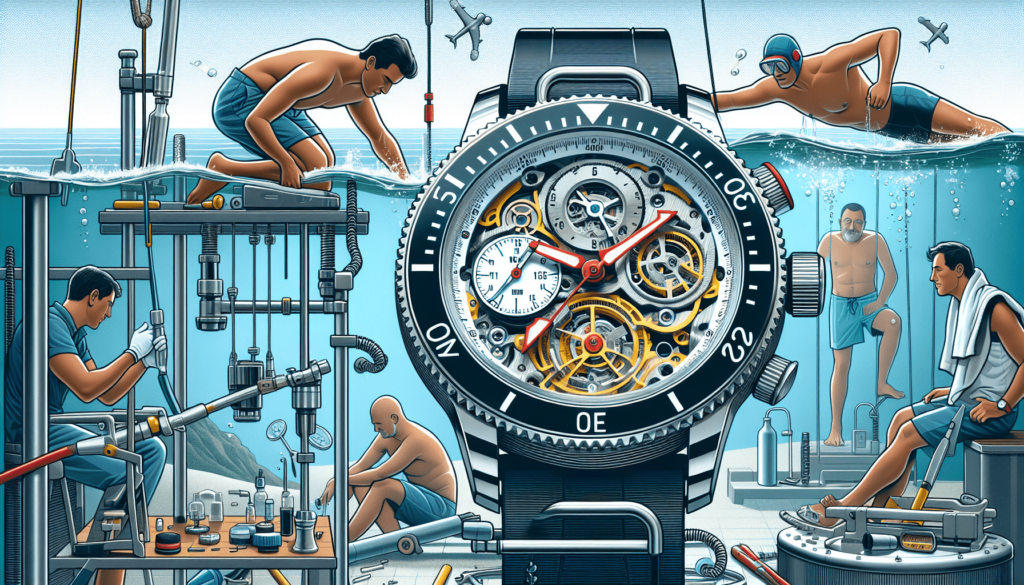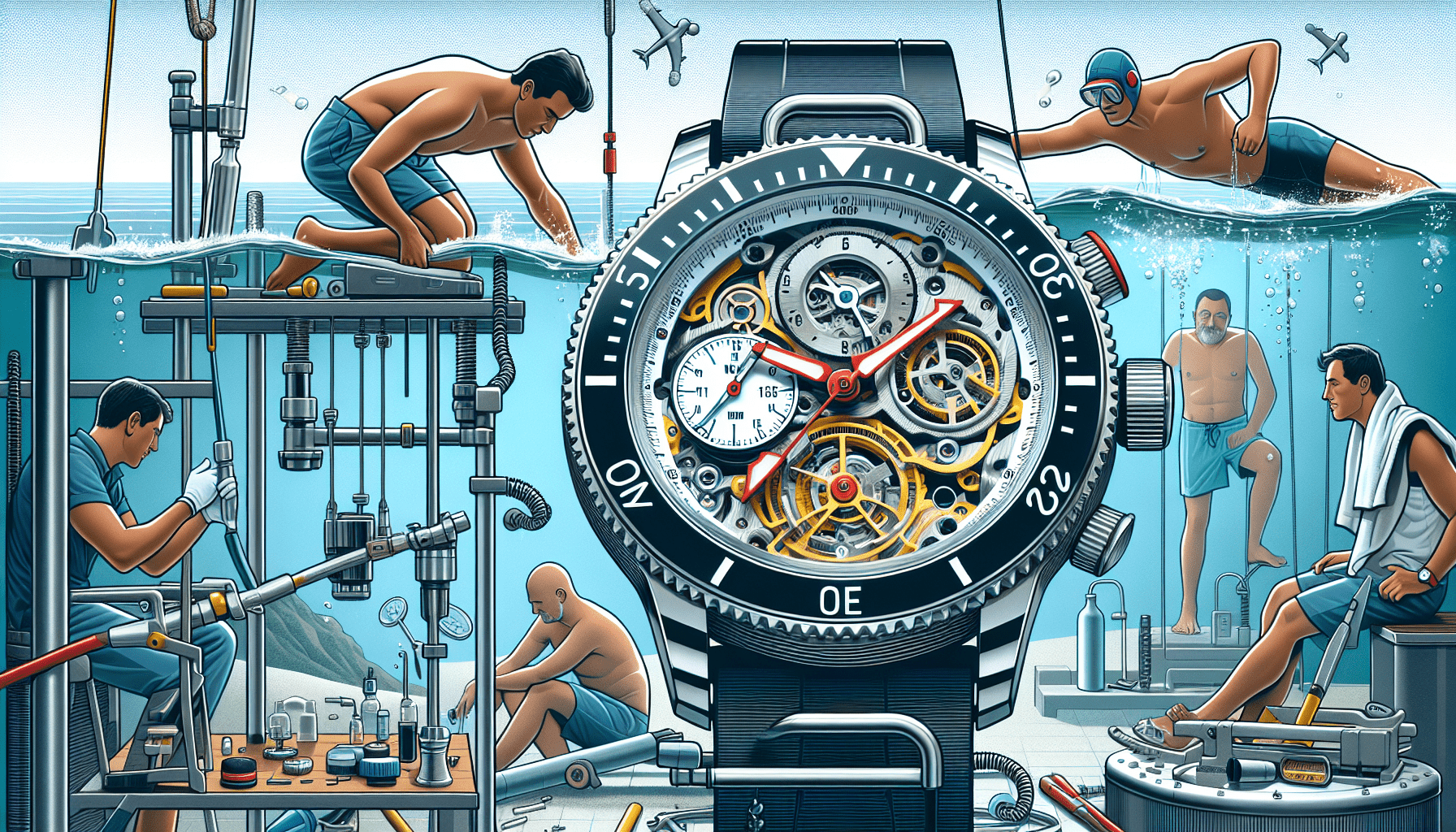Imagine this scenario: you’re out hiking in the rugged wilderness, surrounded by breathtaking landscapes. As you march on, your wristwatch catches your eye – it’s a sleek and stylish piece that effortlessly complements your adventurous spirit. But have you ever wondered about the significance of water resistance in men’s wristwatches? In this article, we will explore the reasons why water resistance is an essential feature to consider when choosing your next timepiece. Let’s dive into the world of men’s wristwatches and unlock the importance of water resistance.
What is water resistance?
Definition of water resistance
Water resistance refers to the ability of a watch to withstand exposure to water without being damaged. A water-resistant watch is designed to prevent water from entering the internal components and causing potential harm.
Different levels of water resistance
Watches are categorized into different levels of water resistance, which indicate the depth and duration of water exposure they can withstand. These levels range from basic water resistance, suitable for everyday activities and accidental splashes, to higher levels that are suitable for swimming, diving, and other water-related sports.
Water resistance ratings
Water resistance ratings are measured in meters (or feet) and indicate the depth to which a watch can be submerged without water entering its internal mechanisms. Common water resistance ratings include 30 meters (or 100 feet), 50 meters (or 165 feet), 100 meters (or 330 feet), 200 meters (or 660 feet), and even higher for professional diving watches.
Why is water resistance important?
Protecting the watch from water damage
Water resistance is crucial in preventing water from seeping into the watch and damaging its delicate internal components. Water can corrode the movement, rust the gears, damage the dial, and even cause the watch to stop functioning altogether. By having water resistance, you can ensure that your watch remains fully functional even when exposed to water.
Suitable for various activities
Having a water-resistant watch allows you to engage in various water-related activities with peace of mind. You can wear your watch while washing your hands, swimming, or participating in water sports without the fear of water damaging it. This versatility makes water-resistant watches an excellent choice for those with an active lifestyle.
Longer lifespan of the watch
Water resistance not only protects the watch in the short term but also contributes to its long-term durability. By preventing water damage, water-resistant watches are less prone to frequent repairs or replacements. They can withstand the test of time and continue to function reliably for years to come.

Determining the level of water resistance needed
Identifying your water-related activities
To determine the level of water resistance needed in a watch, it is essential to assess the water-related activities you regularly engage in. If you often find yourself near water or frequently participate in water sports, you will require a watch with a higher water resistance rating. On the other hand, if your exposure to water is minimal, a watch with basic water resistance will likely suffice.
Understanding water resistance ratings
Familiarizing yourself with water resistance ratings is crucial in selecting the appropriate level of water resistance for your watch. It is important to note that water resistance ratings are based on measurements in still water. Watches should not be subjected to extreme water pressures or rapid movements underwater unless specifically designed for such conditions.
Choosing the appropriate level of water resistance
When choosing a watch with water resistance, it is advisable to opt for a higher rating than what you anticipate needing. This adds an extra layer of protection, ensuring that your watch can withstand unexpected water exposure without incurring damage. It is always better to have more water resistance than less, especially if you lead an active lifestyle.
Factors affecting water resistance
Quality of materials and construction
The quality of materials and construction plays a significant role in determining a watch’s water resistance. High-quality watches are built with precision and attention to detail, using materials that are resistant to water infiltration. The case, crystal, and seals must be of superior quality to prevent water from entering the watch.
Sealing mechanisms
The sealing mechanisms implemented in a watch are vital for its water resistance. Durable seals, such as rubber gaskets and O-rings, are strategically placed to create a watertight seal between various components of the watch. Properly sealed crowns and casebacks also contribute to maintaining the watch’s water resistance.
Proper maintenance and care
Regular maintenance and care are essential in preserving a watch’s water resistance over time. Ensuring that the seals are intact, lubricating the gaskets when necessary, and avoiding unnecessary exposure to water are crucial steps in maintaining a watch’s water resistance. Adhering to manufacturer guidelines for servicing and care will help prolong the lifespan of the watch.

Different types of water resistance seals
Rubber gaskets
Rubber gaskets are commonly used in watches to create watertight seals. These flexible seals are placed between various components, such as the crystal and the case, or the caseback and the case, to prevent water from entering the watch. The high elasticity and durability of rubber gaskets make them an effective sealing mechanism.
O-rings
O-rings are another type of seal often found in water-resistant watches. These circular rubber rings are positioned in the watch’s joints and provide an airtight seal, preventing water from penetrating the interior. O-rings are known for their excellent resistance to water and temperature variations, making them a reliable component in water-resistant watches.
Screw-down crowns
Screw-down crowns are designed to create a secure seal when the crown is tightened. To adjust the time or date, the crown must be unscrewed and then securely tightened afterward. This mechanism ensures that even if the crown is accidentally pulled out, water cannot infiltrate the watch, maintaining its water resistance.
Sealed casebacks
Sealed casebacks, also known as screw-down casebacks, are tightly screwed onto the watch case to create a watertight seal. They provide an additional layer of protection against water infiltration and are commonly found in watches with higher water resistance ratings. The screw-down mechanism further reinforces the watch’s overall water resistance.
Testing water resistance
Manufacturers’ tests
Watch manufacturers often subject their watches to rigorous tests to determine their water resistance capabilities. These tests involve exposing the watches to various water pressures and durations, simulating real-life scenarios. By testing their watches extensively, manufacturers can provide accurate water resistance ratings and ensure the reliability of their products.
ISO standards
The International Organization for Standardization (ISO) has established guidelines and standards for water resistance testing. These standards ensure that watches undergo consistent testing procedures and are assigned appropriate water resistance ratings. Adhering to ISO standards provides consumers with confidence in the accuracy and reliability of a watch’s water resistance claim.
Third-party certification
Some watches may undergo additional testing by independent third-party organizations that specialize in certifying water resistance. These certifications serve as an extra layer of assurance for consumers, confirming that the watch has been thoroughly tested and meets the defined water resistance standards. Third-party certifications add credibility to a watch’s water resistance claims.
Common misconceptions about water resistance
Confusing water resistance with waterproof
One common misconception is mistaking water resistance for being completely waterproof. While water-resistant watches can withstand certain levels of water exposure, they are not impervious to water. Exceeding the indicated water resistance rating or subjecting the watch to extreme water pressures can still lead to water damage.
Effects of temperature changes
Extreme temperature changes can affect the water resistance of a watch. Sudden exposure to high heat or extreme cold can cause the materials to expand or contract, potentially compromising the watch’s sealing mechanisms. It is important to avoid subjecting a water-resistant watch to sudden and drastic temperature fluctuations to ensure its water resistance remains intact.
Degradation of water resistance over time
Water resistance is not permanent and can degrade over time due to various factors. Exposure to chemicals, heavy impacts, or wear and tear can weaken the seals and compromise the watch’s water resistance. Regular inspection, servicing, and proper care are essential for maintaining a watch’s water resistance and preventing any potential deterioration.
Water resistance maintenance and care
Regular inspections and servicing
Regularly inspecting water-resistant watches for any signs of damage or wear is crucial in maintaining their water resistance. If any issues are detected, it is recommended to have the watch serviced by a professional watchmaker. They can replace worn-out seals, lubricate gaskets, and ensure that the watch remains properly sealed and water-resistant.
Avoiding exposure to extreme conditions
To preserve the water resistance of a watch, it is important to avoid exposing it to extreme conditions. This includes avoiding prolonged exposure to high-pressure water, hot showers, saunas, or environments with significant temperature fluctuations. Additionally, protecting the watch from unnecessary impacts or strong chemicals will help maintain its water resistance over time.
Proper usage and handling
Using the watch according to its intended purpose and adhering to manufacturer guidelines is crucial in preserving its water resistance. Avoid diving or swimming with a watch that is not rated for such activities. Handling the watch with care, not forcefully turning the crown or pushing buttons underwater, and avoiding unnecessary rough usage will all contribute to maintaining its water resistance.
Popular men’s watches with high water resistance
Rolex Submariner
The Rolex Submariner is one of the most iconic and highly regarded water-resistant watches for men. With a water resistance rating of 300 meters (1,000 feet), it is designed for professional diving and extensive water-related activities. The Submariner is equipped with robust sealing mechanisms, including a screw-down crown and caseback, ensuring its exceptional water resistance.
Omega Seamaster
The Omega Seamaster is another popular choice renowned for its water resistance capabilities. With various models offering different levels of water resistance, the Seamaster collection caters to divers, sailors, and other individuals seeking a reliable and water-resistant timepiece. Many Seamaster models feature screw-down crowns and casebacks, as well as highly effective sealing mechanisms.
TAG Heuer Aquaracer
The TAG Heuer Aquaracer collection is specifically designed for aquatic sports enthusiasts. These watches boast impressive water resistance ratings, ranging from 200 meters (660 feet) to 300 meters (1,000 feet), depending on the model. With robust construction and reliable sealing mechanisms, the Aquaracer watches provide durability and water resistance for demanding water-related activities.
Casio G-Shock
While not traditionally considered a luxury watch, the Casio G-Shock collection offers exceptional water resistance and ruggedness for outdoor enthusiasts. G-Shock watches are designed to withstand rough conditions, making them popular among individuals engaging in water sports and other adventurous activities. With water resistance ratings of up to 200 meters (660 feet), G-Shock watches can handle various water-related challenges.
Conclusion
Water resistance is a crucial feature in men’s wristwatches, offering protection from water damage, versatility for various activities, and ensuring a longer lifespan. By identifying your water-related activities, understanding water resistance ratings, and choosing a watch with an appropriate level of water resistance, you can enjoy the benefits of a reliable timepiece. Factors such as quality materials and construction, sealing mechanisms, and proper maintenance also contribute to a watch’s water resistance. Clearing up common misconceptions and following recommended maintenance practices will help preserve the water resistance capabilities of a watch. Popular men’s watches with high water resistance, such as the Rolex Submariner, Omega Seamaster, TAG Heuer Aquaracer, and Casio G-Shock, exemplify the importance of water resistance in different contexts. Ultimately, with the appropriate level of water resistance and proper maintenance, your watch can withstand water exposure and provide you with years of reliable timekeeping.

